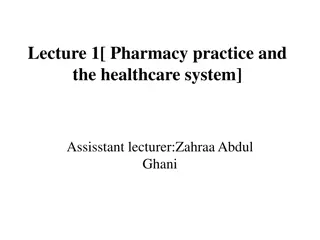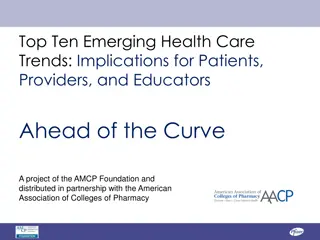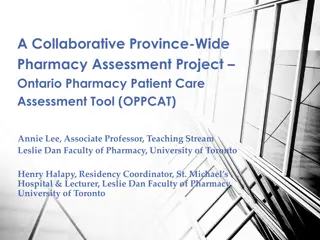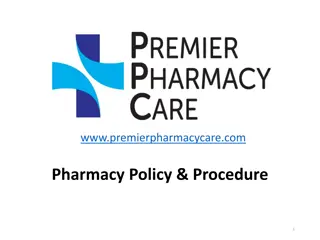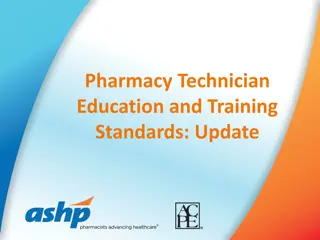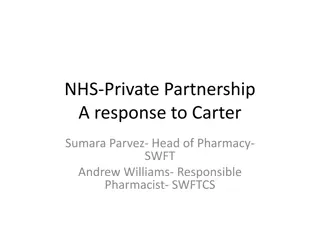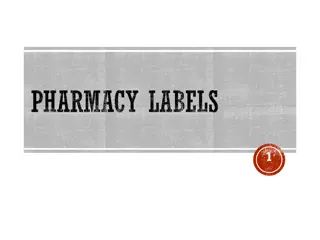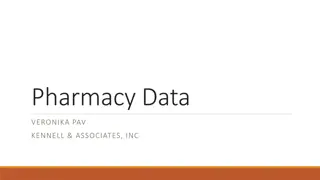Posology in Pharmacy
Posology is a crucial aspect of pharmaceutical science that focuses on determining the appropriate dosage and quantity of drugs for patients to achieve desired effects. Factors such as age, sex, body weight, route of administration, and environmental considerations play a significant role in dose determination. This branch of medical science aims to optimize drug therapy for patients of all ages and conditions.
Download Presentation

Please find below an Image/Link to download the presentation.
The content on the website is provided AS IS for your information and personal use only. It may not be sold, licensed, or shared on other websites without obtaining consent from the author.If you encounter any issues during the download, it is possible that the publisher has removed the file from their server.
You are allowed to download the files provided on this website for personal or commercial use, subject to the condition that they are used lawfully. All files are the property of their respective owners.
The content on the website is provided AS IS for your information and personal use only. It may not be sold, licensed, or shared on other websites without obtaining consent from the author.
E N D
Presentation Transcript
POSOLOGY M. Venkata Swamy Associate Professor,MLRIP Department of Pharmaceutics 1
INTRODUCTION Department of Pharmaceutics 2
Cont.. . Department of Pharmaceutics 3
Cont. . Dosage for each indication, each method/route of administration as appropriate: Dose recommendations Frequency of dosing e.g. mg, mg/kg, mg/m2 e.g. once or twice daily or every 6 hours Department of Pharmaceutics 4
Cont. . This word is derived from Greek word posos how much and logos means science. So posology is a branch of medical science which deals with dose & quantity of drugs which can be administered to a patient to get a desired action. In this, there are many factors which influence the doses. Department of Pharmaceutics 5
Factors affecting dose 1.Age 2. Sex 3. Body Weigh 4. Route of Administration 5.Time of Administration 6. Environmental Factors 7. Emotional factors 8. Presence of disease 9. Accumulation 10. Additive effects 11. Synergism epartment of Pharmaceutics 12. Antagonism 14. Tolerance 15. Tachyphylaxis 16. Metabolic disturbance D 6
1. AGE The pharmacokinetics of many drugs changes with age. - Newborn infants (pediatric) are abnormally sensitive to certain drugs because of the immature state of their hepatic and renal function by which drugs are inactivated and eliminated from the body. Failure to detoxify and eliminate drugs results in their accumulation in the tissues to a toxic level. - Whereas, elderly patients are more sensitive to some drug effect e.g. hypnotics which may produce confusion state in them. Department of Pharmaceutics 7
2. SEX Women do not always respond to the action of drug in the same manner as it done in men. Special care should be taken when drugs are administered during menstruation, pregnancy & lactation. The strong purgative eg. Aloes should be avoided during menstruation. Similarly the drugs which may stimulate the uterine smooth muscles e.g. drastic purgative, antimalarial drugs, ergot alkaloids are contra indicated during pregnancy. - Alcohol, barbiturate, narcotic drugs acts on foetus through placenta. During lactation, morphine, tetracycline avoided because its affect on babies. Department of Pharmaceutics 8
3. BODY WEIGH The average dose is mentioned either in terms of mg per kg body weight. Another technique used as a total single for an adult weighing between 50-100kg. However, the dose expressed in this fashion may not apply in case of obese patients, children & malnourished patients. It should be calculated according to body weight Department of Pharmaceutics 9
4. ROUTE OF ADMINISTRATION I.V doses of drug are usually smaller than the oral doses. Intravenous route this might enhance the chances of drug toxicity. The effectiveness of drug formulation is generally controlled by the route of administration. Department of Pharmaceutics 10
5. TIME OF ADMINISTARTION The presence of food in the stomach delay the absorption of drug & rapidly absorbed from the empty stomach. But it does not mean that much effective when taken during or after meal. Iron, arsenic & cod-liver oil should be given after meal & antacid drugs taken before meal. Department of Pharmaceutics 11
6. ENVIROMENTAL FACTORS The personality & behavior of a physician may influence the effect of drug especially the drugs which are intended for use in a psychosomatic disorders. The females are more emotional than male & required less dose of certain drugs. Inert dosage forms called placebos which resemble the actual medicament in the physical properties are known to produce therapeutic benefit in disease like angina pectoris & bronchial asthma. Department of Pharmaceutics 12
7. PRESENCE OF DISEASE Drugs like barbiturates & chlorpromazine may produce unusually prolonged effect in patient having liver cirrhosis. Such as, streptomycin produce toxic effect on these patient their kidney function is not working properly because streptomycin excreted through kidney. Department of Pharmaceutics 13
8. ACCUMULATION Some drugs produces the toxic effect if it is repeatedly administered for long time e.g. digitalis, emetine, heavy metals because these drugs excreted slowly. This occurs due to accumulative effect of the drug. Department of Pharmaceutics 14
9. ADDITIVE EFFECT When two or more drugs administered together is equivalent to sum of their individual pharmacological action, the phenomenon is called as additive effect. E.g ephedrine & aminophylline in the treatment of bronchial ashtma. Department of Pharmaceutics 15
SYNERGIS M When desired therapeutic result needed is difficult to achieve with single drug at that time two or more drugs are used in the combination form for increasing their action this phenomenon is called synergism. - E.g. procaine & adrenaline combination, increase the duration of action of procaine. Department of Pharmaceutics 16
10. ANTOGONISM When the action of one drug is opposed by the other drug on the same physiological system is known as drug antagonism. The use of antagonistic response to drugs is valuable in the treatment of poisoning. E.g. milk of magnesia is given in acid poisoning where alkaline effect of milk of magnesia neutralise the effect of acid poisoning. When adrenaline & acetylcholine are given together, they neutralise the effect of each other due to antagonism because adrenaline is vasoconstrictor & acetylcholine is Department of Pharmaceutics 17
vasodilator. Department of Pharmaceutics 18
11. IDIOSYNCRACY Idiosyncrasy is also called as allergy. An extraordinary response to a drug which is different from its characteristic pharmacological idiosyncrasy. E.g. small quty. of aspirin may cause gastric hemorrhage. E.g some persons are sensitive to penicillin & sulphonamide because they produce severe toxic effect. action is called Department of Pharmaceutics 19
12. TOLERANCE When an unusually large dose of a drug is required to elicit an affect ordinarily produced by the normal therapeutic dose of the drug, the phenomenon is called as drug tolerance. E.g. smokers can tolerate nicotine, alcoholic can tolerate large quantity of alcohol. The drug tolerance is of two types: True tolerance, which is produced by oral & parenteral administration of the drug. Pseudo tolerance, which is produced only to the oral route of administration. Department of Pharmaceutics 20
13. TACHYPHYLAXIS When some drugs administered repeatedly at short intervals, the cell receptors get blocked up & pharmacological response to that drug decreased. The decreased response cannot be reversed by increasing the dose this phenomenon is called tachyphylaxis or acute tolerance. - E.g. ephedrine given repeated dose at short intervals in the treatment of bronchial asthma may produce very less response due to tachyphylaxis. Department of Pharmaceutics 21
14. METABOLIC DISTURANCE Changes in water electrolyte balance & acid base balance, body temperature & other physiological factor may modify the effect of drug. E.g. salicylates reduce body temperature in only in case an individual has rise in body temperature. They have no antipyretic effect if the body temperature is normal. Department of Pharmaceutics 22
Calculations of doses- 1. Doses proportionate to age: Young s formula- Dose for child = Age in years . Adult dose Age in years + 12 Dilling s formula- Dose for child = Age in years . Adult dose Department of Pharmaceutics 23
20 Department of Pharmaceutics 24
Doses proportionate to body weight: Clark s formula- Dose for child = child s weight in Kg . Adult dose 70 Department of Pharmaceutics 25
Doses proportionate to surface area: Percentage of adult dose= Surface area of child. 100 Surface area of adult Department of Pharmaceutics 26
veterinary doses. The dose required for animals are more or on higher in comparison of human beings just because of body weight, size etc. Therefore it s very important for supply the correct dose. Department of Pharmaceutics 27
Factors affecting on veterinary doses. 2. Sex 3. Body Weigh 4. Route of Administration 5. Time of Administration 6. Environmental Factors 7. Habit 8. Rate of elimination 9. Effect of drug 10. Purpose of medication 12. Character of drug Department of Pharmaceutics 28












